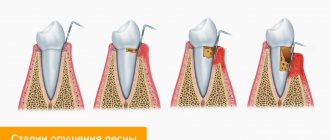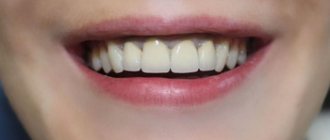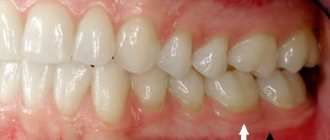After the installation of a titanium implant is completed, it is necessary that it be completely covered with bone tissue and mucous membrane: this ensures the conditions for its successful engraftment into the bone. But situations arise when the edge of the implant becomes visible due to bone and gum deficiency. Such defects are eliminated by performing bone grafting and gingivoplasty - operations to increase the volume of tissue around the implant.
In order not to trigger a pathology that significantly impairs aesthetics, it is important to notice the initial manifestations of this complication in time.
Why is the gum exposed under the implant?
Implant exposure is a fairly common occurrence. More common with two-stage implantation. A characteristic sign is the exposure of the metal rim of the abutment under the prosthesis, resulting in the formation of a black stripe . Usually the defect makes itself felt some time after the operation.
Common causes of complications:
- using an implant with a polished neck that remains above the bone surface after screwing in;
- too thin mucous membrane;
- overtension of the gingival flap;
- temporary crown pressure;
- poor quality oral care after implantation;
- mechanical trauma to the gums (toothbrush, hard food);
- improper formation of the gingival margin;
- subsidence of the bone as a result of long-term use of artificial teeth.
Why did the implant become exposed?
advanced form of implant exposure
There are many reasons for the surface of implants to be exposed; we would like to point out the most common:
- lack of proper care after implantation;
- smoking, bad habits;
- incomplete penetration of the implant into the bone tissue during installation;
- excessive force during installation, overheating of the bone, which causes necrosis of the bone tissue around the implant;
- incorrect positioning of the implant in the bone;
- unsuccessful bone grafting (bone augmentation);
- During installation, the minimum permissible distances between implants or between the implant and tooth are not observed. For example, placing implants very close to each other causes bone necrosis;
- overload of the implant during operation - improper prosthetics;
- a low-quality abutment or crown is installed on the implant.
What methods are used to treat recession?
Gum recession is manifested by exposure of the root system. The problem negatively affects the appearance and is fraught with the development of pathologies.
In dental practice, there are two ways to treat recession:
- Elimination of the defect using soft tissue plastic surgery . This allows you to adhere to the two-step technique, as well as prevent the development of the infectious process. However, surgery cannot be avoided. Plastic surgery is performed by augmenting the gums.
- Transition to a one-stage operation protocol. The plug is removed and an abutment is placed in its place. This option does not guarantee the possibility of infection and loosening of the implant, since a two-stage implantation method was initially chosen.
Signs of artificial root rejection
The fact that the implant has not taken root or the osseointegration process is disrupted may be indicated by the persistence of symptoms of inflammation a week after surgery. Pain, redness of the gums, and swelling in the first five days are normal, as is a slight increase in temperature. But if more than 7–10 days have passed after installation, but the listed ailments do not go away, but increase, you need to rush to the doctor. In some cases, the patient only feels the mobility of the structure; there may be no other symptoms.
Sometimes implant rejection does not occur in the first month after installation, but in a delayed period, when it would seem that the rod has acquired a stable position. This can be caused by bacterial processes, prosthetic errors, or injuries.
Plastic surgery of soft tissues if a dental implant has come out of the gum
The procedure for correcting the gingival contour and improving the structural and functional state of the periodontium is called gingivoplasty . Allows you to restore the aesthetic appearance of the jaw when implants are exposed in case of recession.
When and in what cases is it carried out?
After implantation, the patient may experience mucosal deficiency and incomplete coverage of the surface of the titanium rod. It looks ugly and causes a deep feeling of discomfort. Plastic surgery of soft tissues is a reasonable way out of this situation. It is indicated if:
- there is a strong tension on the flap;
- the installed crown puts pressure on the gum, blocking its growth around the implant;
- The patient suffered an injury during hygiene procedures or eating food that requires surgical correction.
The procedure has certain risks. Sometimes the doctor has to put a plug on the artificial root. This does not guarantee that infection cannot enter the bone bed. When the rod is exposed, the development of resorption of bone structures is possible.
How is surgery performed if the implant is visible from the gums?
The goal of gingivoplasty is to build up the mucosa to completely cover the surface of the implant. This is done by adding your own tissues from other parts of the oral cavity. The operation is performed by a periodontist under local or general anesthesia, at the patient’s choice.
Before the procedure, a preparatory stage must be carried out, including the elimination of caries, relief of existing inflammatory processes, and removal of tartar.
Extension is carried out:
- in a selected area, usually the palate, a flap of mucous membrane is peeled off;
- applied to the exposed area;
- bone correction is performed if necessary;
- stitches are placed.
Afterwards the graft engraftment stage begins. After 10 days, the sutures are removed, and when tissue fusion is complete, the gum is incised to gain access to the structure and change the former to the abutment.
Possible complications
Gingivoplasty, like any surgical procedure, has its risks. Complications include:
- development of an allergic reaction to the administered anesthetic;
- recurrence of gum recession (requires re-building after 5-6 months);
- swelling of the operated area;
- painful sensations;
- bleeding;
- hematomas.
This is due to the abundant blood circulation of the tissues of the maxillofacial area. Therefore, with the slightest surgical intervention, especially on the lower dentition, severe swelling and bruising appear, which are not as dangerous as they look. After a couple of days their severity decreases, and after a week or two there is no trace left of them.
The appearance of pain in the first hours after the procedure is considered normal. It can be easily managed with analgesics. If the painful sensations increase and do not go away three days after gum growth, then you need to consult a doctor. Perhaps we are talking about the development of a serious pathological process.
Minor bleeding is acceptable in the first hours after the intervention. Intense hemorrhage, in addition to injury to a large vessel, may indicate a blood clotting disorder, which is dangerous. Preoperative examination, including this indicator, is important.
Numbness of the face after the anesthesia wears off is a rare but unpleasant phenomenon. This is a sign of serious nerve damage. Restoring its functions usually takes at least 4 months and requires treatment.
Possible complications
Dental implantation is a complex operation that requires careful preparation. As a rule, complications arise after poor-quality prosthetics or non-compliance with the recommendations of the attending physician. One of the most common problems is exposure of the neck of an adjacent tooth. Normally, it should be covered with gum tissue. Exposing the area between the crown and the root is a reason to contact the dentist. If the necessary measures are not taken in time, the following complications may occur:
- mobility of the dental unit,
- periodontal pockets,
- tooth root caries,
- inflammation of tissues with suppuration,
- fistula on the gum.
Implantation using a one-stage installation method - solving the problems of implant exposure
The one-stage method of installing an artificial tooth is popular due to the immediate aesthetic result. The procedure is carried out in one stage, including the following actions of the doctor:
- examination of the patient for contraindications;
- sanitation of the oral cavity, elimination of existing problematic issues;
- removal of the desired tooth;
- preparing a bone bed for a titanium root;
- screwing in the implant;
- installation of abutment and temporary crown.
Once healing is complete, the temporary prosthesis will be replaced with a permanent one.
How to identify postoperative complications? Characteristic symptoms of implant rejection
The first thing to know about implant failure is that it does not necessarily start immediately after surgery. It may take months or even years after the implantation of a denture before the first symptoms of rejection appear. However, the first signs that the implant is not taking root may appear during the healing period, which can greatly complicate the diagnosis.
The following symptoms indicate problems with implant healing:
- swelling of the gums and swelling at the site of implantation (may appear during the healing period even if implantation is successful);
- inflammatory process in the gum, change in its color, unpleasant odor from the installation site;
- bleeding at the implant site (possible in the first few days after successful implantation);
- discharge of pus from the gums at the implantation site;
- strong pain.
As you can see, some of the symptoms are characteristic of the normal course of the postoperative period. Therefore, in order not to miss the onset of inflammatory processes and not to start the rejection process, it is important to inform the doctor about all changes in the condition in the postoperative period.
What to do to prevent receding gums after implant placement
You can avoid unpleasant situations by following simple rules:
- take medications prescribed by the doctor in a timely manner;
- rinse your mouth regularly with antiseptic solutions;
- treat the operated area with care;
- stop smoking;
- do not eat hard, sour, hot, cold foods;
- avoid thermal procedures, such as baths, saunas, hot baths;
- treat sutures with a special ointment prescribed by a doctor;
- brush your teeth twice a day (in the morning - after breakfast, in the evening - before bed);
- use an irrigator, floss.
To identify problem areas in a timely manner, you should visit your dentist periodically.
Is it possible to undergo re-implantation?
Even despite the difficulties and complications that arise, many patients wish to undergo a repeat procedure. This is possible, but you must first establish what the reasons and signs were for implant rejection. Each case is considered separately.
Features of re-implantation, depending on the causes of the complication:
- a medical error was made, it is necessary to contact another specialist;
- the patient did not comply with the recommendations, then additional consultation is carried out about behavior after implantation;
- natural rejection occurred due to an allergic reaction, etc., then it is possible to install another type of prosthesis;
- the product was of poor quality, then you should choose another clinic and a different type of pin.
If the patient had contraindications that he did not know about or did not inform the implantologist about, re-implantation is impossible. As in the case when the body does not perceive any foreign bodies.
How is the repeat procedure performed?
Implantation can be performed next time only after 4 - 8 weeks. The structure is first dismantled and a course of medications is prescribed to eliminate inflammation, restore tissue and strengthen the immune system.
The success of re-implantation is influenced by compliance with the technique of removing the first implant. Depending on the condition, the product can be removed with simple manipulations, but if access to the pin is limited, the gum is excised. In the case where the artificial root has partially taken root, sawing of the bone will be required.
How to prepare for gingivoplasty?
You can make an appointment at our clinic in Moscow by phone number or using the feedback form on the website. First, you need to come for a consultation with a dentist, who will assess the amount of work, offer a treatment option and preliminarily determine the price for gum surgery when the tooth root is exposed, for example. Or he will tell you everything that is necessary to solve your clinical situation.
Before the operation, perform:
- treatment of carious cavities;
- elimination of acute inflammatory processes.
After gingivoplasty (local or generalized), you will have a healthy, beautiful and naturally radiant smile.
The stitches are removed after 10-12 days.
After gum surgery
Provoking factors
Recession is clinically manifested by exposure of the neck of the structure. A black stripe appears in the interaction zone, which can become an entry point for infection.
Pathology develops as a result of medical error or objective factors.
The list of objective factors includes:
- After tooth extraction, the vestibular plate becomes susceptible to resorption. The thinner the plate, the more susceptible the gum tissue is to loss.
- Thickness of the mucous membrane layer. The tissue covering the alveolar ridge bone during unit extraction suffers from recession.
- The degree of resection of reimplant bone. Resorption of bone tissue provokes loss of gum tissue.
The list of subjective factors includes:
- Implant diameter. It is recommended to use structures with a platform diameter of up to 5 mm.
- Position of the rod in the bone. The direction of the implant axis must coincide with the value of natural units.
- Duration of installation of the prosthesis. Complete formation of the gingival level is completed after four weeks. Prosthetics started earlier than the specified period can provoke a recession.
- Failure to maintain the distance between the rods and the outer surface of the cortical bone.
- Contamination of the area of interaction between the implant and periodontium.
- Medical errors during implant fixation, non-compliance with technology.
A patient can provoke the onset of gum recession by his actions:
- Poor care of dentures.
- Smoking and other bad habits.
- Damage to gums when brushing teeth or eating.
Some experts are of the opinion that implants with belts in the area of interaction with the soft shell can provoke recession. However, there is no confirmation of this information.
What to do if an implant falls out
What to do if something goes wrong after prosthetics? Can the structure be saved or will it have to be removed?
The first thing to do when pain and swelling appears is to consult a dentist. Don't expect the problem to go away. The more time you waste, the more serious the consequences will be. You should not self-medicate; home remedies will not help maintain the prosthesis and relieve inflammation.
If signs of rejection are detected or an inflammatory process is diagnosed, the titanium structure must be removed. The resulting cavity is cleared of pus, granulation tissue, and necrotic masses. Antiseptic treatment is carried out.
A mandatory stage is local and general anti-inflammatory therapy. Taking antibiotics localizes the source of inflammation and destroys the pathogen. With proper treatment and timely treatment, signs of the disease can be stopped within 1-2 weeks. If you delay visiting the clinic, the consequences can be serious. Such patients usually require surgical treatment.
Advantages of our center for modern dentistry:
Why you should contact Uniklinik Center for Modern Medicine LLC in Moscow:
- Our clinic employs doctors of medical sciences, professors, and dentists who regularly take advanced training courses in Russia and European countries.
- For 15 years we have been providing dental services of very high quality.
- The clinic has a computed tomograph, a cephalostat, a digital modeling system, and a dental microscope.
- We use modern treatment methods - invasive bone surgery, immediate implantation, tooth extraction, periodontal surgery, all types of prosthetics and orthodontic treatment.
Thanks to such a thorough and comprehensive approach to each patient, and coordinated work in a team of highly qualified doctors, for many years we have been obtaining very highly aesthetic and functional work, which our patients enjoy with great joy.
How is peri-implantitis treated?
The success of treatment for peri-implantitis depends on what stage of the disease it is started at: the earlier, the better the prognosis.
Treatment is aimed primarily at relieving inflammation in the area and restoring bone volume once it has begun to be lost. Therefore, there are 2 main stages in treatment - sanitation of the inflamed area and surgical bone augmentation.
- Before starting treatment, the doctor conducts a diagnosis. The main stage of such a diagnosis will be a 3D CT scan to accurately determine the affected area and the condition of the bone tissue.
- Then professional hygiene of the implant and adjacent areas is carried out - removal of soft dental deposits and tartar from the dental crown and from the subgingival space using ultrasound.
- Next, surgical sanitation of the area of inflammation is carried out - the abscesses are opened. Cleaning of periodontal pockets is carried out in the same way as for periodontal diseases - using special curettes or the Vector device. It is advisable that the problematic implant is not loaded.
- At the same time, bone grafting can be performed using the method of directed bone regeneration using bone chips and regenerating membranes.
- In parallel, the patient is given local and general antibacterial therapy and antibiotics are prescribed.
- When treating peri-implantitis, it is very important to maintain daily hygiene using antiseptic drugs.
The result of treatment is necessarily monitored by repeated x-ray diagnostics.
It must be remembered that peri-implantitis is prone to frequent relapses, therefore, after treatment, monitoring the condition of the implants and increased attention to proper hygiene are MANDATORY.
Prevention
If you decide to install an implant, contact a good clinic that uses systems from well-known manufacturers and has appropriately qualified specialists. The dentist will select a suitable design and will not make mistakes when installing it. Don’t save money; cheap implants from dubious manufacturers are often rejected.
Before the procedure, undergo an in-depth examination, remember all the diseases you have suffered, and any unpleasant symptoms that have bothered you recently. Get tested and consult with relevant specialists. If contraindications are identified, there is no point in performing implantation.
After the procedure, follow your dentist's recommendations. At first, you should not put a full chewing load on the tooth. Avoid hard foods. Only a fully implanted implant can withstand significant pressure. When you can fully use an artificial tooth, your doctor will tell you. It depends on the type of structure and implantation technique.
Pay attention to oral hygiene. To thoroughly clean the interdental spaces and stimulate blood circulation in soft tissues, it is recommended to use an irrigator. The device will gently remove plaque and food debris, and the use of special rinses serves to prevent inflammation. Visit your dentist twice a year. This is recommended for all patients, but is especially important if you have implants.
If you smoke, before implantation, consider whether you are ready to give up the bad habit. Nicotine impairs blood circulation in the gums, increases the risk of bleeding, and negatively affects regenerative processes. This serves as an obstacle to the engraftment and long-term operation of the titanium structure. If you are not sure that you will quit smoking, choose a different method of restoring your teeth.
Existing correction options
The choice of method for correcting the slipped gum margin is determined by the clinical situation. There are three variants of pathology:
- Apical edge migration. The bone volume is maintained in sufficient quantity. The implant is stable.
- Migration with bone deficiency. Stability has been maintained.
- Loss of gum tissue, bone resorption, implant mobility.
The first two clinical situations require periodontal plastic surgery. In the third case, the implant is replaced and tissue deficiency is filled.











